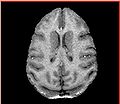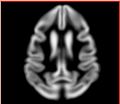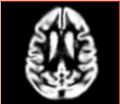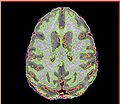2010 Winter Project Week VervetMRILongitudinalAnalysis
Key Investigators
- Andriy Fedorov, Ron Kikinis (BWH)
- Ginger Li, Chris Wyatt (VT)
Objective
We are developing methods for analysis of structural images from nonhuman primates for identifying regional differences in brain morphometry caused by interactions of stress and alcohol exposure. Specifically, we are focused on vervet monkey species. Our objective is to develop image analysis workflow for accurate and reproducible segmentation of vervet brain to facilitate morphometry studies. Ideally, we would like to have the complete workflow implemented using 3DSlicer tools.
Approach, Plan
Given two serial T1 scans for 10 vervet subjects, our approach is the following:
1. (Semi-)manually segment GM/WM/CSF and certain subcortical structures for one of the subjects
2. Build probabilistic tissue atlas using the baseline images
3. Register follow-up to baseline
4. Use the atlas and automated segmentation tools to identify subcortical structures in all subjects for the baseline and follow-up
Alternatively, instead of the Steps 1 and 2 we could use UNC Rhesus atlas, if the structural changes between the rhesus and vervet brains are not significant, and we can successfully perform deformable registration.
The focus of our work at AHM will be on Step 4 above. Given two types of atlases:
- Vervet atlas we constructed
- Rhesus atlas prepared by UNC group
... and three approaches to segmentation:
- EM Segmenter in Slicer 3.4
- itkEMS and/or ABC Slicer 3.5 extension (are they different?)
- fluid deformable registration of the atlas to a subject
we will study what combination works best for our data, based on the subjective evaluation of the segmentation results.
Progress
Prior to the meeting (current progress and notes):
- completely redesigned atlas construction workflow, prepared detailed documentation
- prepared 3-class and subcortical segmentations for one subject (semi-manually)
- atlas construction workflow is now composed completely from Slicer/NA-MIC Kit tools
- initial version of the re-worked vervet probabilistic atlas completed
During the meeting:
- testing and fine-tuning segmentation tools -- Work with: EM Segmenter/Kilian Pohl, itkEMS/ABC/Marcel Prastawa; try to complete segmentation of baseline and followup scans
- improving deformable registration of rhesus atlas to vervet, if needed (initial results available) Work with: Luis Ibanez, Jim Miller, Dominik Maier, Casey Goodlett, Hans Johnson ... any expertise in registration is welcome
- collect overall comments on the workflow from the related experience in similar workflows (Martin Styner)
References
- NA-MIC NCBC Collaboration:Measuring Alcohol and Stress Interaction
- Vervet atlas construction workflow
- Relevant papers and studies from UNC:
- UNC Rhesus brain atlas
- Comparison between EM Segmenter and itkEMS
- M. Styner, R. Knickmeyer, S. Joshi, C. Coe, S. J. Short, and J. Gilmore. Automatic brain segmentation in rhesus monkeys. Proc SPIE Medical Imaging Conference, Proc SPIE Vol 6512 Medical Imaging 2007, pp 65122L-1 - 65122L-8 [http://www.google.com/url?sa=t&source=web&ct=res&cd=1&url=http%3A%2F%2Fwww.cs.unc.edu%2F~styner%2Fpublic%2FMyPapers%2Fpapers%2FMedical%2520Imaging%25202007%2520Image%2520Processing%25202007%2520Styner-
- R. C. Knickmeyer, M. Styner, S. J. Short, G. R. Lubach, C. Kang, R. Hamer, C. L. Coe, and J. H. Gilmore, "Maturational trajectories of cortical brain development through the pubertal transition: Unique species and sex differences in the monkey revealed through structural magnetic resonance imaging," pp. bhp166+, August 2009. DOI
- BRAINSFit registration tools (Hans Johnson, UIowa) on NITRC
- N4 bias correction (Nick Tustison, UPenn) on Insight Journal
- Slicer 3.4 EM Segmenter
- UNC itkEMS
- Slicer 3.5 ABC extension




